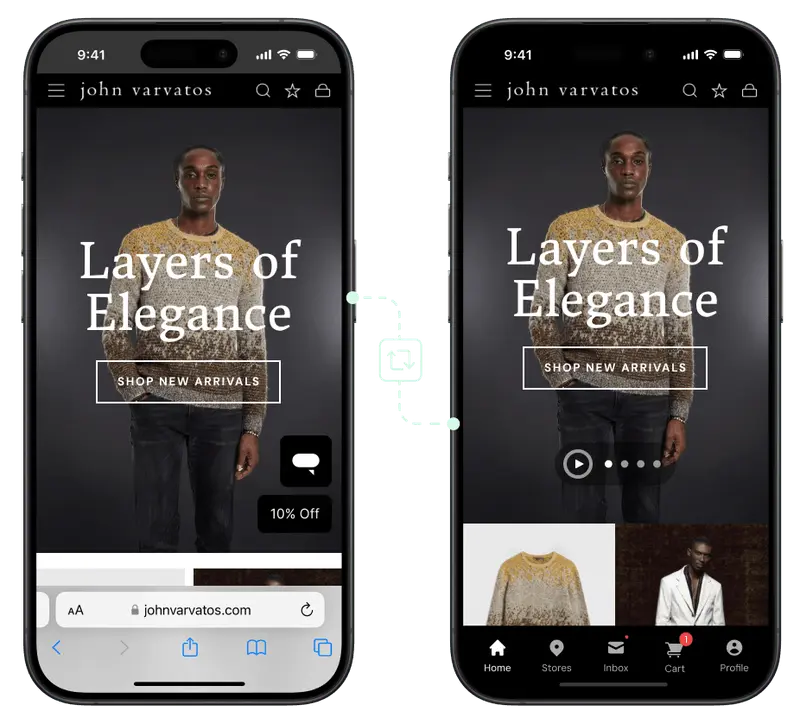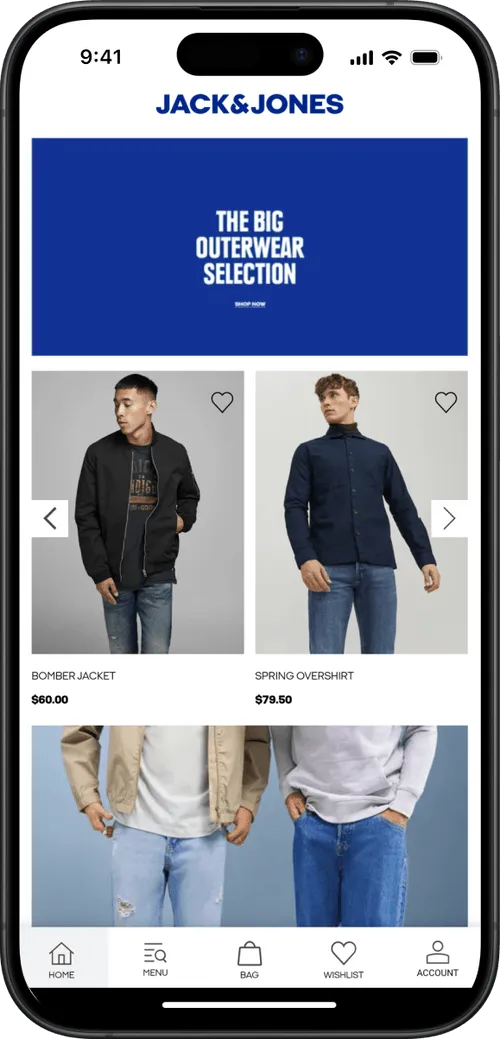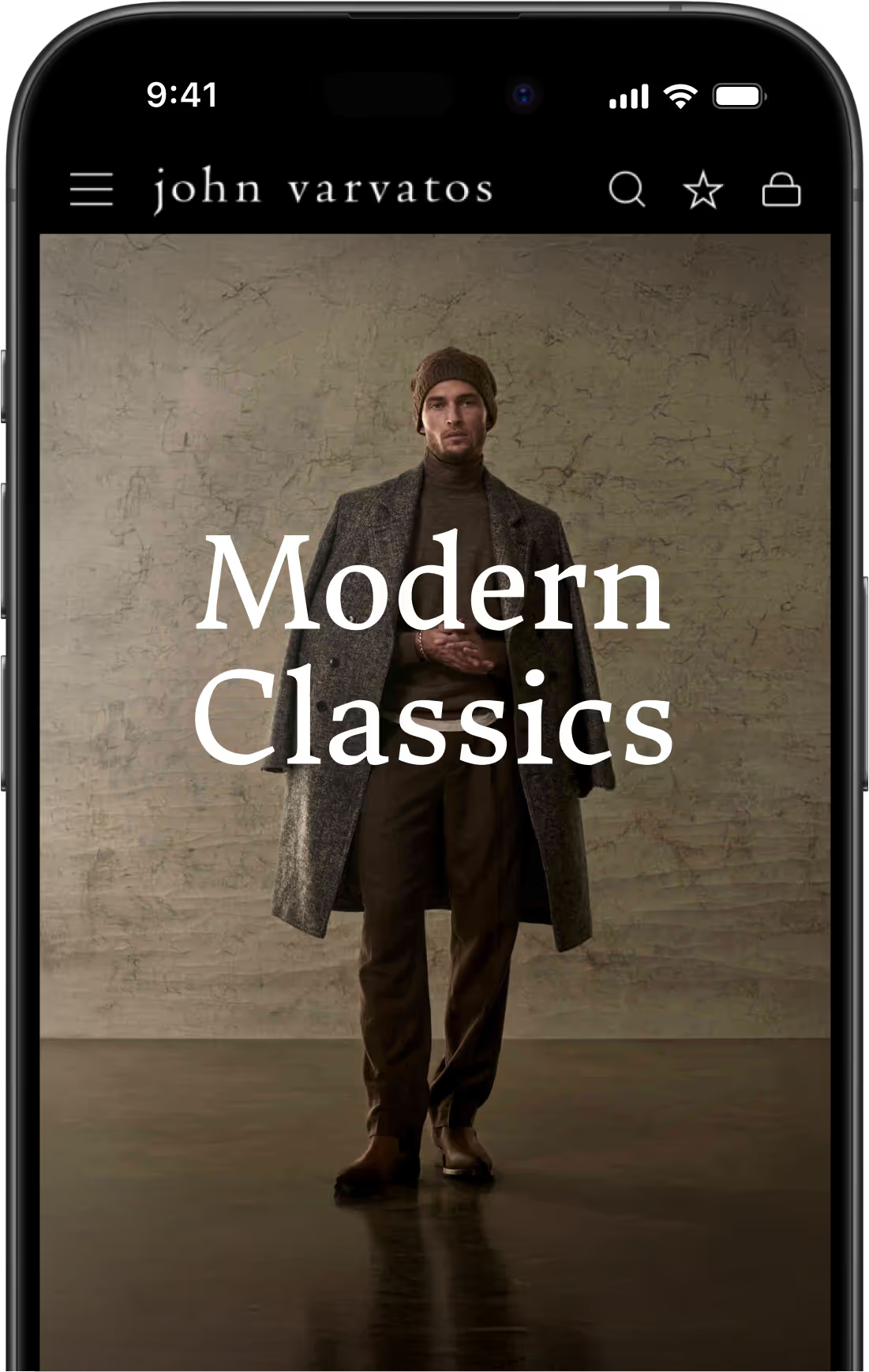Selling cookware, furniture, housewares, or home décor online isn’t the same as selling a T-shirt. Customers browse deeper, compare sets, and return multiple times before making a purchase. Many also reorder essentials, like kitchen tools, appliances, or décor pieces, again and again.
Yet on mobile web, these experiences are clunky, slow, and easy to abandon. Whether it’s cookware reorders, browsing furniture collections, or finding the perfect décor piece, customers want speed, convenience, and a direct connection to the brands they trust.
A mobile app delivers exactly that. It puts your store on the home screen, makes reordering seamless, and opens a powerful new channel with push notifications.
With MobiLoud, you can launch fully branded iOS and Android apps in weeks – without rebuilding your site or taking on the cost and complexity of custom development.
Why Cookware, Furniture, and Home Décor Brands Need Mobile Apps
Home & Kitchen ecommerce is booming, but competition is intense. Mobile now accounts for the majority of traffic. Yet mobile websites often struggle with conversion, speed, and retention.
For cookware, furniture, housewares, and décor brands, that means missed opportunities with high-intent buyers.
Mobile apps solve this gap. Industry benchmarks show that ecommerce apps:
- Convert 3x higher than mobile websites
- Generate 10-50% higher average order values
- Deliver up to 4x more revenue per user than mobile web
Push notifications amplify this further. Our data finds that they drive 3-5x higher click-through rates than email, with average conversion rates of ~4%.
Certain flows, such as abandoned cart notifications, perform exceptionally well, with conversion rates up to 22% in some cases.
Push notifications are a powerful channel to drive repeat purchases, announce back-in-stock furniture, or nudge customers to reorder cookware and housewares.
For verticals like Home & Kitchen, where customers browse deeply, compare, and often buy in sets, apps are especially powerful.
They make product discovery smoother, checkout faster with native payments, and reordering just a tap away.
That translates into higher revenue per customer, stronger loyalty, and a durable edge over brands that rely solely on mobile web.
Home & Kitchen Mobile App Development: 3 Options Compared (Cookware, Décor, Housewares, Furniture)
When Home & Kitchen brands decide to launch an app, they usually consider three paths: hiring a native agency, using a template builder, or converting their website into apps with MobiLoud. Each comes with trade-offs in cost, speed, and long-term ROI.
1. Native App Development (Agencies or In-House)
The traditional path to building an app is hiring an agency or in-house developers to design and code fully native iOS and Android applications from scratch.
At first, this can sound appealing. You get complete creative freedom and the ability to craft completely bespoke experiences.
However, the investment and long-term complexity of building a custom app is too much for most brands.
Pros:
- Maximum flexibility and control over the look, feel, and functionality of the app.
- Ability to build unique, powerful features (for example, AR for furniture placement).
- Full ownership of the codebase.
Cons:
- Cost: Native apps are expensive. Agencies often quote six figures per platform just to launch, with ongoing development and maintenance on top. For most Home & Kitchen brands, the ROI simply isn’t there.
- Time: Custom development projects can take 6–12 months or longer. That’s a year of opportunity cost where competitors may already be reaping the benefits of app revenue.
- Complexity: Every update to your ecommerce store needs to be duplicated in the app. If you tweak your cookware PDP design, add a new furniture collection layout, or update checkout flows, developers need to manually replicate those changes in the native codebase.
- Maintenance burden: Keeping up with iOS and Android updates, app store requirements, and bug fixes requires a dedicated product and engineering team.
For most Home & Kitchen brands, this level of investment and ongoing complexity doesn’t make sense.
Unless you’re a global enterprise with unlimited budget and a product vision that truly demands unique native functionality, the cost and time outweigh the benefits.
2. Template App Builders
Another common option is using a template-based app builder. These platforms are marketed to Shopify or WooCommerce merchants as a quick way to turn your store into an app.
You pick from a set of pre-made templates, drag and drop modules, and connect your catalog to auto-populate the app.
At first glance, this can feel like a low-cost shortcut. You get into the App Store and Google Play quickly, without paying agency rates.
For very simple stores, that can be enough. But Home & Kitchen brands rarely have “simple” ecommerce needs.
Cookware companies rely on bundles, furniture brands have large catalogs with variants and customization, and décor or housewares stores depend on content and merchandising to inspire purchases. Template builders usually struggle to handle this complexity.
Pros:
- Lower upfront costs compared to native development.
- Faster initial launch timeline (often measured in weeks).
- Easy setup with drag-and-drop tools, no coding required.
Cons:
- Rigid templates: These platforms force you into a limited set of layouts. Your carefully optimized PDPs, furniture lookbooks, or cookware bundle flows won’t transfer over cleanly.
- Feature gaps: Third-party integrations like reviews, loyalty, or financing tools often don’t carry through. For Home & Kitchen brands that rely on trust signals and upsell mechanics, that’s a major drawback.
- Separate content management: Many builders require you to manage content twice; once in your site’s CMS and again in the app dashboard. That duplication creates extra work and inconsistencies over time.
- Design trade-offs: Apps built this way often feel generic. For brands selling high-value furniture or premium kitchenware, a cookie-cutter experience undermines brand positioning.
- Scalability limits: As your business grows, you may quickly hit the ceiling of what the platform can do. Migrating off later usually means starting from scratch.
For cookware, furniture, and home décor brands that depend on merchandising, storytelling, and a seamless customer journey, a DIY builder will not be enough.
Template builders are best suited for small stores with basic catalogs, not established Home & Kitchen retailers looking to build loyalty and grow repeat revenue.
3. MobiLoud: Website-to-App Service

MobiLoud takes a different approach from both custom development and template app builders.
Instead of rebuilding your ecommerce store in native code or forcing it into a rigid template, MobiLoud transforms your existing website into fully native iOS and Android apps.
The site you already invested in becomes the foundation of your app – with nothing lost in the process.
This matters a lot for Home & Kitchen brands. Your website isn’t just a catalog, it’s a finely tuned sales engine.
It likely includes custom PDP layouts for cookware sets, lookbooks and inspiration galleries for furniture and décor, upsell flows for housewares, and integrations with reviews, loyalty, and financing tools.
With MobiLoud, all of that comes through intact. No compromises, no duplication, no rebuilding.

How it works:
MobiLoud converts your existing mobile website into a native app, adding the mobile app-specific features that matter most, like push notifications, a native tab bar, splash screens, and app-only settings.
We handle everything: design configuration, testing, QA, app store submission, and ongoing updates. You continue running your website as usual, and the app automatically stays in sync.
Pros:
- No rebuild required: Your entire site powers the app, so you keep all your merchandising, PDPs, checkout flows, and custom features.
- Fast launch: Apps are typically live in ~4 weeks, compared to months for agencies.
- Done-for-you service: We handle design, configuration, publishing, and ongoing maintenance. Your team doesn’t need technical knowledge or spare bandwidth.
- Full branding and polish: Apps are customized to feel fully native and on-brand, not like a cookie-cutter template.
- Scalable: Works with any ecommerce platform or tech stack, so you’re not locked into Shopify-only or limited ecosystems.
- Ongoing support: Our team acts as an extension of yours, helping with push strategy, analytics, and growth after launch.
Cons:
- Because the app mirrors your site, it isn’t meant for brands looking to build a completely separate native experience.
For cookware, furniture, and home décor brands, MobiLoud strikes the ideal balance. You get into the App Store and Google Play quickly, you unlock the powerful engagement of a mobile app, and you do it without the cost, complexity, or compromises of the other two approaches.
The result is an app that looks and feels fully native, drives revenue from day one, and requires almost no ongoing lift from your team.
Want to see what’s possible? Get a free preview of your app now.
Why MobiLoud is the Best Choice for Home & Kitchen, Cookware, and Furniture App Development
For cookware, furniture, housewares, and home décor brands, the case for a mobile app is clear.
The real question is: how do you build one without wasting time, money, or focus?
MobiLoud is designed to give you exactly that. An app that works, without the compromises. Here are the biggest advantages to MobiLoud’s web-to-app approach:
Faster launch, lower risk
While agencies take 6–12 months and builders force you into templates, MobiLoud apps are typically live in around 4 weeks.
You skip the rebuild and go straight to results. That means you start generating app revenue sooner, and with far less upfront investment.
Keep your site, don’t duplicate your work
You’ve already spent countless hours optimizing your website. MobiLoud doesn’t make you rebuild or replatform.
Everything you’ve invested in – PDP design, reviews, bundles, loyalty integrations, financing widgets – works in the app exactly as it does online.
You manage one platform (your site) and the app stays automatically in sync.
A done-for-you, white-glove service
Unlike DIY builders, MobiLoud isn’t a tool you’re left to figure out.
Our team handles design, configuration, testing, QA, publishing, and ongoing updates.
We also work with you strategically, on push notification campaigns, analytics, and app promotion, to ensure the app isn’t just live, but performing.
Native enhancements that drive engagement
Your app won’t just mirror your site in a browser wrapper.
MobiLoud apps come with a native tab bar, launch screen, push notifications, app-only settings, and a polished UX that feels fully at home in the App Store and Google Play.
Customers won’t know the difference between your app and a million-dollar app built from scratch. They’ll just know it works.
Proven results with global brands
We’ve partnered with hundreds of ecommerce and retail brands, including global names like Jack & Jones and Estée Lauder, as well as specialized DTC businesses.
In every case, the goal is the same: higher conversion, stronger loyalty, and revenue growth from mobile apps – without the headaches of custom development.
Step-by-Step Process to Build a Mobile App for Home & Kitchen, Cookware, and Décor Brands
Launching an app with MobiLoud is fast, predictable, and requires very little effort from your team.
Our process is designed to remove the technical and operational burden so you can stay focused on running your business. Here’s what it looks like:
1. Kickoff & Setup
We start with a short kickoff call to align on goals, branding, and the look and feel of your app.
2. Development
Our team configures the initial build, pulling directly from your existing website.
We customize the native elements of your app, like the tab bar, navigation, launch screen, and app settings, so it feels fully branded and polished.
3. Testing & QA
You receive a test version of your app to explore on your own devices.
This gives you the chance to review the experience end-to-end – whether that’s adding cookware bundles to cart, browsing décor galleries, or checking out furniture with financing options.
Our team runs through a detailed QA checklist, making sure your app works flawlessly across iOS and Android devices, with no bugs or rough edges.
4. App Store Submission
We handle all the technical requirements, compliance, and back-and-forth with Apple and Google.
No need to learn the ins and outs of developer accounts or store guidelines. We do it for you.
Before launch, we fine-tune everything based on your feedback. We also advise on best practices for your app store listings to maximize visibility and downloads.
5. Launch & Growth
Your apps go live in the App Store and Google Play within weeks.
From there, our team continues to support you, helping with push notification campaigns, analytics setup, and strategies to grow downloads and revenue.
For Home & Kitchen brands, this process means you can move from idea to live, revenue-generating apps in under a month, with zero disruption to your ecommerce operations.
Ready to see your Home & Kitchen site as a native app? Get a free preview now.
Essential Mobile App Features for Cookware, Furniture, and Housewares Ecommerce Brands
An app isn’t just about presence in the App Store. It’s about features that actually move the needle on revenue, loyalty, and customer experience. For Home & Kitchen brands—where customers research deeply, build bundles, and reorder frequently—these features matter most:
Seamless Product Discovery
Your full catalog carries over to the app, including cookware sets, furniture collections, and décor categories.
Advanced filtering, visual navigation, and collection-based merchandising make it easier for shoppers to browse and compare.
Frictionless Checkout
Native checkout integrations like Apple Pay, Google Pay, and Shop Pay make it possible for customers to buy in a single tap.
This reduces cart abandonment, especially for repeat housewares or appliance purchases.
Push Notifications
Push is the biggest revenue driver for ecommerce apps.
Use it to announce seasonal décor drops, back-in-stock furniture, cookware bundle promotions, or cart reminders.
With 30–40% open rates and no per-send cost, the ROI of push notifications dramatically outperform email and SMS.
Loyalty and Reviews
Apps built with MobiLoud retain your existing integrations. Loyalty programs, reviews, and referral tools remain fully functional. Helping you keep trust and engagement front and center.
Reordering Made Simple
For consumables like cookware accessories, coffee makers, or cleaning supplies, “buy again” flows and saved carts make reordering effortless.
Wishlists and gift registries are also powerful drivers for décor and furniture sales.
Content and Support
Inspiration and guidance are central to Home & Kitchen shopping.
Your app can showcase recipe content, installation guides, or seasonal lookbooks, directly from your existing site. Native in-app chat and returns portals make support easier too.
Native App Enhancements
MobiLoud apps aren’t just website wrappers. They include a polished tab bar, splash screen, app settings, and native navigation, making the experience feel seamless and professional to customers.
Together, these features transform your mobile presence from a mobile web fallback into a high-performing sales and retention channel.
FAQs: Building Mobile Apps for Home & Kitchen, Cookware, and Furniture Brands
Will our large catalog and product variations work in the app?
Yes. Because MobiLoud apps are powered directly by your website, your entire catalog (including cookware bundles, furniture variants, housewares kits, and décor collections) works exactly as it does online. There’s no need to rebuild product data or sacrifice merchandising.
Can we keep our PDP design, reviews, and custom features?
Absolutely. Everything that makes your website convert (custom PDP layouts, reviews and ratings, loyalty integrations, financing tools, or upsell flows) comes through intact. With MobiLoud, your app looks and feels like your site, but optimized with native navigation and mobile UX.
How long does it take to launch?
Most Home & Kitchen brands launch their iOS and Android apps in approximately 4 weeks. We manage the full process end-to-end, including testing, QA, and app store submission.
Do we need technical expertise or a development team?
No. MobiLoud is a fully managed service. Our team handles configuration, publishing, and ongoing updates. Your team simply manages the website as usual. The app stays automatically in sync.
How do push notifications compare to email or SMS?
Push is one of the most effective engagement channels. Visibility and engagement is significantly higher than email, with unfiltered messages that land on your customer’s lock screen. And compared to SMS, push notifications are more direct, and cheaper, making them a more flexible and scalable mobile marketing channel.
What about app maintenance over time?
We take care of it. MobiLoud monitors updates from Apple and Google, ensures compliance with app store requirements, and rolls out ongoing optimizations. You’ll never need to worry about patching code or rebuilding to keep your app live.
What if we decide to change platforms or redesign our site?
No problem. Because the app mirrors your website, any changes you make to your ecommerce platform or site design automatically carry over to the app. If you replatform from Shopify to another system, the app follows. No rebuild required.
How does the investment compare to other options?
MobiLoud is a fraction of the cost of custom development and delivers far more polish and flexibility than template builders. There’s a predictable monthly fee, no revenue share, and no six-figure upfront risk.
Launch Your Home & Kitchen, Cookware, or Furniture Mobile App in Just a Few Weeks
Mobile apps have become the new standard for ecommerce. For Home & Kitchen brands – whether you’re selling cookware, furniture, décor, or housewares – they’re a proven way to lift conversion, build loyalty, and capture more repeat revenue.
The challenge has always been how to build an app without the cost, complexity, and risk of traditional development.
With MobiLoud, you don’t have to compromise. You can turn your existing website into polished, fully branded iOS and Android apps in just a few weeks, with no duplication of effort and no technical burden on your team.
Ready to see it for yourself? Request a free interactive preview of your app today and discover how easy it is to bring your Home & Kitchen brand into the App Store and Google Play.







